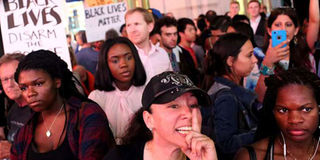Discrimination of minorities ultimately leads to resistance

Activists protest in Times Square in New York City, the US July 7, 2016 in response to fatal shootings of two black men – Alton Sterling and Philando Castile – by police in the country. PHOTO | YANA PASKOVA | AFP
What you need to know:
- If there is one lesson for Kenyans to take from recent racial politics in America, it is that conscious actions of discrimination and marginalisation by the powerful against particular sectors in society will inevitably lead to discontent and reaction.
- And we can only hope that the reaction and resistance is as peaceful as Black Lives Matter has been.
The more things change, the more they stay the same. As I travel around the USA, talking to activists, grassroots groups and others working to survive and move from marginalisation, this saying keeps playing in my mind.
The year 2008 was supposed to herald a new America, a country that some even called the beginning of a “post-racial” society. But eight years since the election of Barack Obama, it seems that not much changed to improve the conditions of the poor, marginalised sectors of US society.
In fact, it appears that the election of Barack Obama has made things worse on the racial front, giving rise to the Tea Party faction of the Republican Party and the emergence of Donald Trump, whose utterances resonate with mostly white males.
So while the election of President Obama was a humungous sign of progress, it was shocking to a substantial segment of Americans, who saw it as the confirmation of their decreased importance in society, and a repudiation of their privileged status.
A large part of the racism problem revolves around the criminalisation of blacks within the criminal justice system in the US. Fully, a third of all black males in the US are in jail or will go to jail in their lifetime.
As civil rights lawyer Michelle Alexander writes in her seminal book, The New Jim Crow: Mass Incarceration in the Age of Colorblindness, the US has the largest prison population in the world, at more than 2 million, exceeding countries like China, Russia and India. And in Washington DC, which is majority black, three of four young black men can expect to serve time in prison.
MORE CRIMINALLY-MINDED
Now this is not about blacks being any more criminally-minded than others. This is a product of the Reaganite War on Drugs started in 1992 (before the explosion of crack cocaine crisis in 1995). In fact, as Ms Alexander states, “studies show that people of all colours use and sell drugs at remarkably similar rates.” In fact some studies show that white youth are more likely to engage in drug crime than people of colour.
So the question arises: why the assault against young blacks using the criminal justice system? Ms Alexander submits that the reason for the incarceration of blacks at such astonishing numbers is a new form of Jim Crow, which was the system created after the abolition of slavery to ensure the subservience and marginalisation of blacks, hence the title of the book.
Be that as it may, what is clear is that prison time in the US comes with a whole set of disadvantages including restrictions on voting, working, education, public benefits and housing that ultimately lead convicts back to crime simply to survive. In effect, blacks who have been to prison end up discriminated against, and in situations very similar to slavery and under the Jim Crow system.
Now, to jail such an inordinately number of people requires policing that is aggressive and racially tinged. And this is what has given rise to the series of protests across America after the deaths by police of black men in various cities. In Ferguson, Missouri for instance traffic fines were factored into the revenue streams for the city, meaning that police aggressively and discriminately sought small mistakes in order to fine people to reach the target incomes. Thus Michael Brown was eventually killed, after being stopped for walking on the road instead of the sidewalk which did not exist.
The anger in the black community is palpable and the impact of Black Lives Matter movement is massive. The black community is organising and trying to stand up against decades of harassment and humiliation. And in order to be more effective, it is organising across racial lines, seeking alliances with other aggrieved and marginalised groups and communities.
So if there is one lesson for Kenyans to take from recent racial politics in America, it is that conscious actions of discrimination and marginalisation by the powerful against particular sectors in society will inevitably lead to discontent and reaction.
And we can only hope that the reaction and resistance is as peaceful as Black Lives Matter has been.





